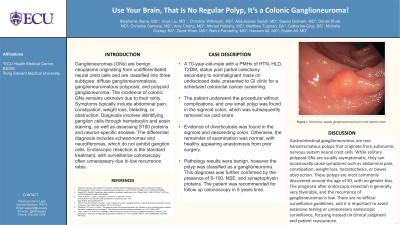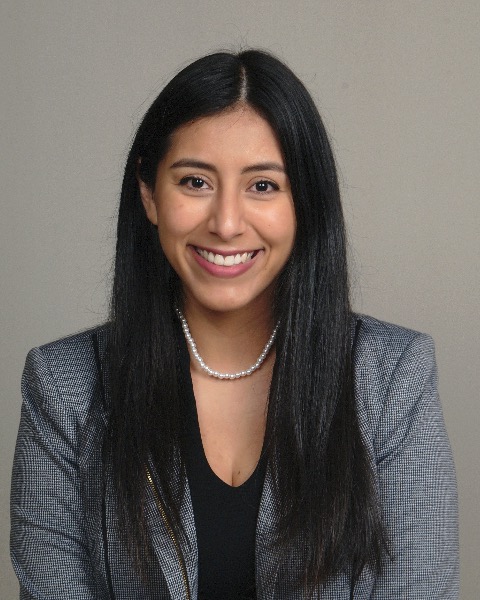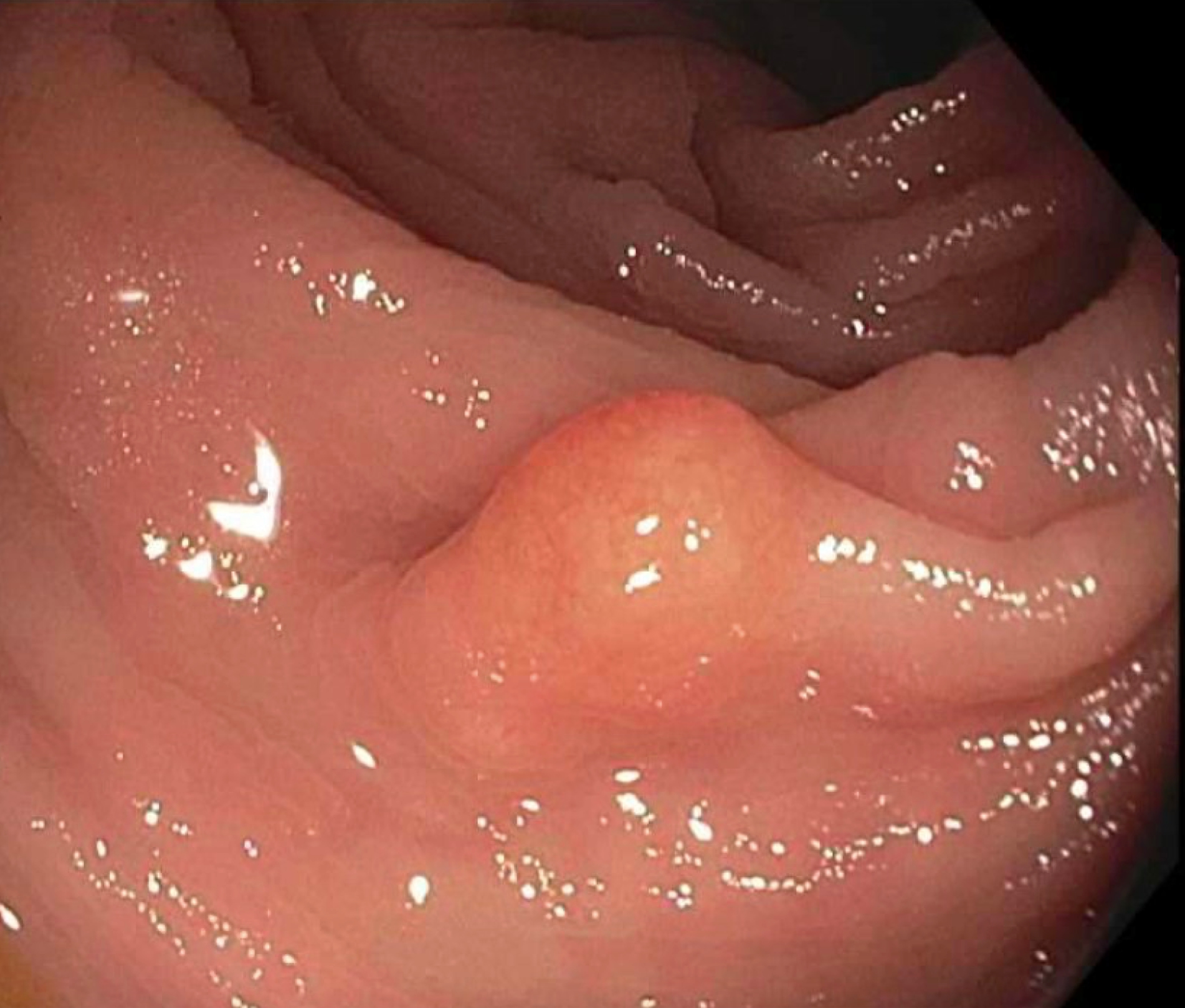Tuesday Poster Session
Category: Colorectal Cancer Prevention
P3876 - Use Your Brain, That Is No Regular Polyp, It’s a Colonic Ganglioneuroma!
Tuesday, October 29, 2024
10:30 AM - 4:00 PM ET
Location: Exhibit Hall E

Has Audio

Stephanie Ibarra, MD
East Carolina University Medical Center
Greenville, NC
Presenting Author(s)
Stephanie Ibarra Lepe, MD1, Jinye Liu, DO1, Christin Wilkinson, MD2, Abdulazeez Swaiti, MD2, Saeed Graham, MD2, M Danial Ali Shah, MD3, Christina Santana, MD1, Amy Chang, MD1, Ahmed Hebishy, MD4, Matthew Tugman, BA4, Catherine Gray, BS4, Michelle Cooley, BS4, Zarak Khan, MD5, Rahul Pamarthy, MD2, Hassam Ali, MD2, Eslam Ali, MD1
1East Carolina University Medical Center, Greenville, NC; 2East Carolina University, Greenville, NC; 3King Edward Medical University, Lahore, Punjab, Pakistan; 4East Carolina University Brody School of Medicine, Greenville, NC; 5East Carolina Gastroenterology, Greenville, NC
Introduction: Ganglioneuromas (GNs) are benign neoplasms originating from undifferentiated neural crest cells and are classified into three subtypes: diffuse ganglioneuromatosis, ganglioneuromatous polyposis, and polypoid ganglioneuroma. The incidence of colonic GNs remains unknown due to their rarity. Symptoms typically include abdominal pain, constipation, weight loss, bleeding, or obstruction. Diagnosis involves identifying ganglion cells through hematoxylin and eosin staining, as well as assessing S100 proteins and neuron-specific enolase. The differential diagnosis includes schwannomas and neurofibromas, which do not exhibit ganglion cells. Endoscopic resection is the standard treatment, with surveillance colonoscopy often unnecessary due to low recurrence rates.
Case Description/Methods: A 70-year-old-male with a PMHx of HTN, HLD, T2DM, status post partial colectomy secondary to nonmalignant mass on undisclosed date, presented to GI clinic for a scheduled colorectal cancer screen. The patient underwent the procedure without complications, and one small polyp was found in the sigmoid colon, which was subsequently removed via cold snare. Additionally, evidence of diverticulosis was found in the sigmoid and descending colon. Otherwise, the remainder of examination was normal, with healthy appearing anastomosis from prior surgery. Pathology results were benign, however the polyp was classified as a ganglioneuroma. This diagnosis was further confirmed by the presence of S-100, NSE, and synaptophysin proteins. The patient was recommended for follow up colonoscopy in 5 years time.
Discussion: Gastrointestinal ganglioneuromas are rare hamartomatous polyps that originate from autonomic nervous system neural crest cells. While solitary polypoid GNs are usually asymptomatic, they can occasionally cause symptoms such as abdominal pain, constipation, weight loss, hematochezia, or bowel obstruction. These polyps are most commonly discovered around the age of 50, with no gender bias. The prognosis after endoscopic resection is generally very favorable, and the recurrence of ganglioneuromas is low. There are no official surveillance guidelines, and it is important to avoid excessive testing or unnecessary endoscopic surveillance, focusing instead on clinical judgment and patient reassurance.

Disclosures:
Stephanie Ibarra Lepe, MD1, Jinye Liu, DO1, Christin Wilkinson, MD2, Abdulazeez Swaiti, MD2, Saeed Graham, MD2, M Danial Ali Shah, MD3, Christina Santana, MD1, Amy Chang, MD1, Ahmed Hebishy, MD4, Matthew Tugman, BA4, Catherine Gray, BS4, Michelle Cooley, BS4, Zarak Khan, MD5, Rahul Pamarthy, MD2, Hassam Ali, MD2, Eslam Ali, MD1. P3876 - Use Your Brain, That Is No Regular Polyp, It’s a Colonic Ganglioneuroma!, ACG 2024 Annual Scientific Meeting Abstracts. Philadelphia, PA: American College of Gastroenterology.
1East Carolina University Medical Center, Greenville, NC; 2East Carolina University, Greenville, NC; 3King Edward Medical University, Lahore, Punjab, Pakistan; 4East Carolina University Brody School of Medicine, Greenville, NC; 5East Carolina Gastroenterology, Greenville, NC
Introduction: Ganglioneuromas (GNs) are benign neoplasms originating from undifferentiated neural crest cells and are classified into three subtypes: diffuse ganglioneuromatosis, ganglioneuromatous polyposis, and polypoid ganglioneuroma. The incidence of colonic GNs remains unknown due to their rarity. Symptoms typically include abdominal pain, constipation, weight loss, bleeding, or obstruction. Diagnosis involves identifying ganglion cells through hematoxylin and eosin staining, as well as assessing S100 proteins and neuron-specific enolase. The differential diagnosis includes schwannomas and neurofibromas, which do not exhibit ganglion cells. Endoscopic resection is the standard treatment, with surveillance colonoscopy often unnecessary due to low recurrence rates.
Case Description/Methods: A 70-year-old-male with a PMHx of HTN, HLD, T2DM, status post partial colectomy secondary to nonmalignant mass on undisclosed date, presented to GI clinic for a scheduled colorectal cancer screen. The patient underwent the procedure without complications, and one small polyp was found in the sigmoid colon, which was subsequently removed via cold snare. Additionally, evidence of diverticulosis was found in the sigmoid and descending colon. Otherwise, the remainder of examination was normal, with healthy appearing anastomosis from prior surgery. Pathology results were benign, however the polyp was classified as a ganglioneuroma. This diagnosis was further confirmed by the presence of S-100, NSE, and synaptophysin proteins. The patient was recommended for follow up colonoscopy in 5 years time.
Discussion: Gastrointestinal ganglioneuromas are rare hamartomatous polyps that originate from autonomic nervous system neural crest cells. While solitary polypoid GNs are usually asymptomatic, they can occasionally cause symptoms such as abdominal pain, constipation, weight loss, hematochezia, or bowel obstruction. These polyps are most commonly discovered around the age of 50, with no gender bias. The prognosis after endoscopic resection is generally very favorable, and the recurrence of ganglioneuromas is low. There are no official surveillance guidelines, and it is important to avoid excessive testing or unnecessary endoscopic surveillance, focusing instead on clinical judgment and patient reassurance.

Figure: Figure 1. Diminutive, sessile ganglioneuroma found in the sigmoid colon
Disclosures:
Stephanie Ibarra Lepe indicated no relevant financial relationships.
Jinye Liu indicated no relevant financial relationships.
Christin Wilkinson indicated no relevant financial relationships.
Abdulazeez Swaiti indicated no relevant financial relationships.
Saeed Graham indicated no relevant financial relationships.
M Danial Ali Shah indicated no relevant financial relationships.
Christina Santana indicated no relevant financial relationships.
Amy Chang indicated no relevant financial relationships.
Ahmed Hebishy indicated no relevant financial relationships.
Matthew Tugman indicated no relevant financial relationships.
Catherine Gray indicated no relevant financial relationships.
Michelle Cooley indicated no relevant financial relationships.
Zarak Khan indicated no relevant financial relationships.
Rahul Pamarthy indicated no relevant financial relationships.
Hassam Ali indicated no relevant financial relationships.
Eslam Ali indicated no relevant financial relationships.
Stephanie Ibarra Lepe, MD1, Jinye Liu, DO1, Christin Wilkinson, MD2, Abdulazeez Swaiti, MD2, Saeed Graham, MD2, M Danial Ali Shah, MD3, Christina Santana, MD1, Amy Chang, MD1, Ahmed Hebishy, MD4, Matthew Tugman, BA4, Catherine Gray, BS4, Michelle Cooley, BS4, Zarak Khan, MD5, Rahul Pamarthy, MD2, Hassam Ali, MD2, Eslam Ali, MD1. P3876 - Use Your Brain, That Is No Regular Polyp, It’s a Colonic Ganglioneuroma!, ACG 2024 Annual Scientific Meeting Abstracts. Philadelphia, PA: American College of Gastroenterology.
